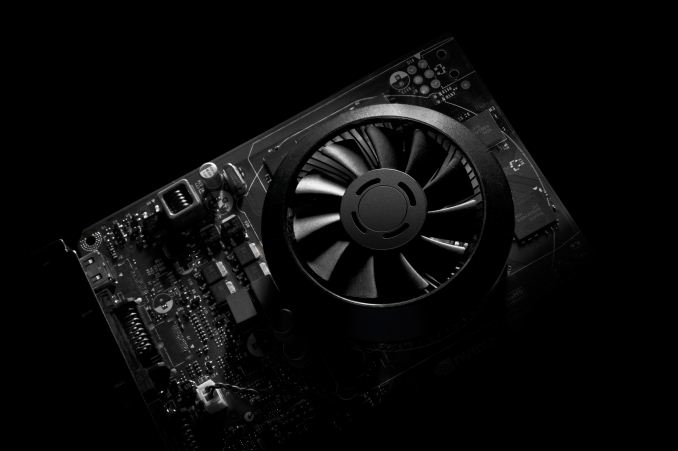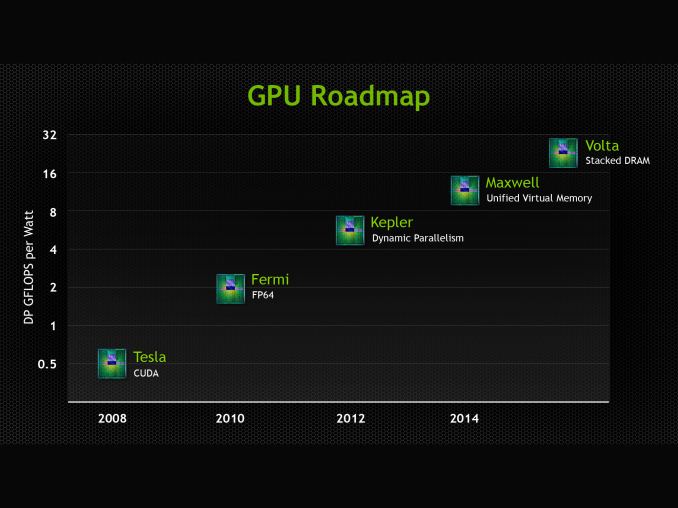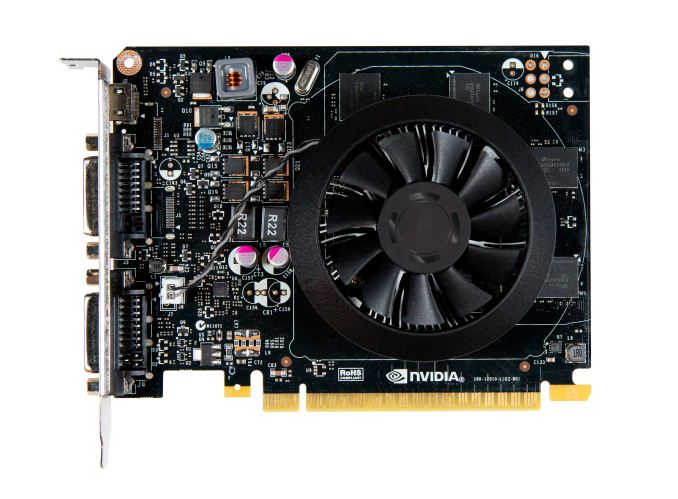The NVIDIA GeForce GTX 750 Ti and GTX 750 Review: Maxwell Makes Its Move
by Ryan Smith & Ganesh T S on February 18, 2014 9:00 AM EST
As the GPU company who’s arguably more transparent about their long-term product plans, NVIDIA still manages to surprise us time and time again. Case in point, we have known since 2012 that NVIDIA’s follow-up architecture to Kepler would be Maxwell, but it’s only more recently that we’ve begun to understand the complete significance of Maxwell to the company’s plans. Each and every generation of GPUs brings with it an important mix of improvements, new features, and enhanced performance; but fundamental shifts are fewer and far between. So when we found out Maxwell would be one of those fundamental shifts, it changed our perspective and expectations significantly.
What is that fundamental shift? As we found out back at NVIDIA’s CES 2014 press conference, Maxwell is the first NVIDIA GPU that started out as a “mobile first” design, marking a significant change in NVIDIA’s product design philosophy. The days of designing a flagship GPU and scaling down already came to an end with Kepler, when NVIDIA designed GK104 before GK110. But NVIDIA still designed a desktop GPU first, with mobile and SoC-class designs following. However beginning with Maxwell that entire philosophy has come to an end, and as NVIDIA has chosen to embrace power efficiency and mobile-friendly designs as the foundation of their GPU architectures, this has led to them going mobile first on Maxwell. With Maxwell NVIDIA has made the complete transition from top to bottom, and are now designing GPUs bottom-up instead of top-down.
Nevertheless, a mobile first design is not the same as a mobile first build strategy. NVIDIA has yet to ship a Kepler based SoC, let alone putting a Maxwell based SoC on their roadmaps. At least for the foreseeable future discrete GPUs are going to remain as the first products on any new architecture. So while the underlying architecture may be more mobile-friendly than what we’ve seen in the past, what hasn’t changed is that NVIDIA is still getting the ball rolling for a new architecture with relatively big and powerful GPUs.
This brings us to the present, and the world of desktop video cards. Just less than 2 years since the launch of the first Kepler part, the GK104 based GeForce GTX 680, NVIDIA is back and ready to launch their next generation of GPUs as based on the Maxwell architecture.
No two GPU launches are alike – Maxwell’s launch won’t be any more like Kepler’s than Kepler was Fermi’s – but the launch of Maxwell is going to be an even greater shift than usual. Maxwell’s mobile-first design aside, Maxwell also comes at a time of stagnation on the manufacturing side of the equation. Traditionally we’d see a new manufacturing node ready from TSMC to align with the new architecture, but just as with the situation faced by AMD in the launch of their GCN 1.1 based Hawaii GPUs, NVIDIA will be making do on the 28nm node for Maxwell’s launch. The lack of a new node means that NVIDIA would either have to wait until the next node is ready, or launch on the existing node, and in the case of Maxwell NVIDIA has opted for the latter.
As a consequence of staying on 28nm the optimal strategy for releasing GPUs has changed for NVIDIA. From a performance perspective the biggest improvements still come from the node shrink and the resulting increase in transistor density and reduced power consumption. But there is still room for maneuvering within the 28nm node and to improve power and density within a design without changing the node itself. Maxwell in turn is just such a design, further optimizing the efficiency of NVIDIA’s designs within the confines of the 28nm node.
With the Maxwell architecture in hand and its 28nm optimizations in place, the final piece of the puzzle is deciding where to launch first. Thanks to the embarrassingly parallel nature of graphics and 3D rendering, at every tier of GPU – from SoC to Tesla – GPUs are fundamentally power limited. Their performance is constrained by the amount of power needed to achieve a given level of performance, whether it’s limiting clockspeed ramp-ups or just building out a wider GPU with more transistors to flip. But this is especially true in the world of SoCs and mobile discrete GPUs, where battery capacity and space limitations put a very hard cap on power consumption.
As a result, not unlike the mobile first strategy NVIDIA used in designing the architecture, when it comes to building their first Maxwell GPU NVIDIA is starting from the bottom. The bulk of NVIDIA’s GPU shipments have been smaller, cheaper, and less power hungry chips like GK107, which for the last two years has formed the backbone of NVIDIA’s mobile offerings, NVIDIA’s cloud server offerings, and of course NVIDIA’s mainstream desktop offerings. So when it came time to roll out Maxwell and its highly optimized 28nm design, there was no better and more effective place for NVIDIA to start than with the successor to GK107: the Maxwell based GM107.
Over the coming months we’ll see GM107 in a number of different products. Its destiny in the mobile space is all but set in stone as the successor to the highly successful GK107, and NVIDIA’s GRID products practically beg for greater efficiency. But for today we’ll be starting on the desktop with the launch of NVIDIA’s latest desktop video cards: GeForce GTX 750 Ti and GeForce GTX 750.













177 Comments
View All Comments
Harag - Thursday, March 6, 2014 - link
Not true at all. The release of the Titan showed they could unlock FP64 performance on a specific architecture. The Titan Black also has amazing FP64 performance. You may also want to look into their Quadro line.kwrzesien - Tuesday, February 18, 2014 - link
Cards are available on Newegg! Check out this EVGA Superclocked (1268MHz) with a dual-fan ACX cooler and 6-pin PCIe power connector: http://www.newegg.com/Product/Product.aspx?Item=N8...Frenetic Pony - Tuesday, February 18, 2014 - link
Maxwell is designed for mobile gaming, in which case who cares? Broadwell looks to improve performance per watt at least as much as Maxwell if Intel's initial hints of 30% power improvement for 14nm and 40% improvement for gpu power efficiency pan out. And they were already damned good.But Maxwell isn't designed for high end, in which case GCN 1.1 and AMD are already beating them for price for performance. Congrats Nvidia, you're second place in both categories if this card is anything to go by. I hope to hell your Titan 2 or whatever kicks more ass than this card.
varad - Wednesday, February 19, 2014 - link
@FreneticPony, statements like "Maxwell is designed for mobile gaming" and "But Maxwell isn't designed for high end" tell us you know precious little. Maxwell is an architecture that will span across all of Nvidia's products [Tegra, GeForce, Quadro and Tesla].Frenetic Pony - Thursday, February 20, 2014 - link
Err... they intend to produce as such yes. But it's obvious the architecture itself is targeted squarely at mobile. Power constraints don't actually get in the way as much as other constraints do on the high end. Who really cares if it's 150+ tdp if it's gaming? You get constrained by memory latency and other things no matter how high you can clock it up.This appears to be Nvidia's version of Haswell, concentrated solely on improving performance per watt rather than performance at all. Which is bad timing as Intel is doing the same, but integrates it's GPUs right onto the chip, making them cheaper and smaller than any dedicated card for a laptop is going to be. Meanwhile AMD is crushing Nvidia in both compute and high end gaming performance on the desktop for performance per $.
True, this will help mitigate electricity cost. for compute based work. But as others pointed out not by much. Meaning Nvidia stuck itself with the wrong focus at the wrong time. Maybe it will help with their Tegra SOCs, if they're lucky they'll get back into the game, as Qualcomm soundly crushed the Tegra 4 for third party ARM Socs over the last year.
So, no, it's designed for high end. Doesn't mean they're not going to do it anyway.
Frenetic Pony - Thursday, February 20, 2014 - link
I.E. it really doesn't matter how well they did at what they're doing. Because Intel has done just as well and has built in advantages for its market, what their doing doesn't help that much against AMD in the high end market, and this leaves their only chance for financial success with it being next years Tegra SOCs.ninjaquick - Thursday, February 20, 2014 - link
Plus, AMD is easily capable of taking Nvidia on at the low end with better hardware across the board, more integrated designs, etc.willis936 - Thursday, February 20, 2014 - link
Pro tip: you're always TDP limited. Increasing performance per watt IS increasing performance.Harag - Thursday, March 6, 2014 - link
Broad statements like "AMD is crushing Nvidia..." only proved @Varad correct. you know precious little.HisDivineOrder - Wednesday, February 19, 2014 - link
nVidia fits a lot more performance in a little more space at a lot less power and you think they're doing poorly? This is on the same node.Imagine what they'll pack into a smaller node.
Their focus is probably the right one, given the fact they want to migrate these cores into Tegra.